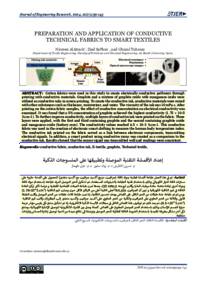Document
Preparation and application of conductive technical fabrics to smart textiles.
Identifier
DOI:10.53540/tjer.vol.21iss2pp139-145
Source
Journal of Engineering Research, v. 21, no. 2, p. 139-145.
Contributors
Saffour, Ziad., Author
AlAtrash, Nisreen., Author
Other titles
إعداد الأقمشة التقنية الموصلة وتطبيقها على المنسوجات الذكية.
Country
Oman
City
Muscat
Publisher
College of Engineering, Sultan Qaboos University.
Gregorian
2024
Language
English
English abstract
Cotton fabrics were used in this study to create electrically conductive pathways through
printing with conductive materials. Graphite and a mixture of graphite oxide with manganese oxide were
utilized as conductive inks in screen printing. To create the conductive ink, conductive materials were mixed
with other substances such as thickener, moisturizer, and water. The viscosity of the ink was 10 mPa.s. After
printing on the cotton fabric samples, the effect of conductive concentration on electrical conductivity was
examined. It was found that a 5% concentration of graphite achieved the highest conductivity (1.75 × 10-5
S.cm-1). To further improve conductivity, multiple layers of conductive ink were printed on the fabric. Three
layers were applied, with the first and third containing graphite and the second containing graphite oxide
and manganese oxide (battery core). The conductivity values reached 6.5 × 10-3 S.cm-1. This conductive
fabric was used in the creation of electronic smart clothing to measure the human body temperature index.
The conductive ink printed on the fabric served as a link between electronic components, transmitting
electrical signals. In addition, a smart product using conductive yarns was created as a comparison to the
conductive ink. Results showed that the sensor signal was transmitted well and readings were consistent.
ISSN
Online: 1726-6742
Print: 1726-6009
Arabic abstract
تم في هذا العمل طباعة أقمشة قطنية بمواد ناقلة (جرافيت، مزيج أكسيد جرافيت مع أكسيد منغنيز) للحصول على أقمشة حاوية على مسارات ناقلة للتيار الكهربائي، وذلك باستخدام تقنية الطباعة بالشاشات المسطحة. تم تشكيل الحبر الموصل المراد طباعة باستخدام مواد ناقلة ومواد أخرى (مادة مذيبة مثل محلول الأمام)، وكانت لزوجته (10 mPa.s). وتمت دراسة تأثير تركيز المادة الناقلة في قيم الناقلية الكهربائية. تبين أن تركيز 5% أعطى ناقلية أعلى من التركيز الأقل حيث وصلت قيم الناقلية (1.75 × 10-5 S.cm-1).
وبهدف تحسين الناقلية، إذ تمت طباعة طبقات من الحبر الموصل وكانت الطبقة الأولى والناقلة من الحبر الجرافيتي على القماش القطني. عند زيادة طبقات الطباعة، زادت قيم الناقلية الكهربائية لتصل إلى (6.5 × 10-3 S.cm-1). يتم توظيف هذا العمل في مجالات الأقمشة الذكية الإلكترونية؛ إذ تم تشكيل منتج ذكي يقيس درجة حرارة الجسم البشري وذلك باستخدام الحبر الموصل المطبوع على القماش. وصل بين الأجزاء الإلكترونية لتوصيل الإشارة إلكترونيًا. ونتج عن ذلك تشكيل منتج يمكنه توصيل الإشارة بكفاءة عالية ويعطي قراءات جيدة من ناحية توصيل إشارة الحساس وقراءات منتظمة.
وبهدف تحسين الناقلية، إذ تمت طباعة طبقات من الحبر الموصل وكانت الطبقة الأولى والناقلة من الحبر الجرافيتي على القماش القطني. عند زيادة طبقات الطباعة، زادت قيم الناقلية الكهربائية لتصل إلى (6.5 × 10-3 S.cm-1). يتم توظيف هذا العمل في مجالات الأقمشة الذكية الإلكترونية؛ إذ تم تشكيل منتج ذكي يقيس درجة حرارة الجسم البشري وذلك باستخدام الحبر الموصل المطبوع على القماش. وصل بين الأجزاء الإلكترونية لتوصيل الإشارة إلكترونيًا. ونتج عن ذلك تشكيل منتج يمكنه توصيل الإشارة بكفاءة عالية ويعطي قراءات جيدة من ناحية توصيل إشارة الحساس وقراءات منتظمة.
Category
Journal articles

